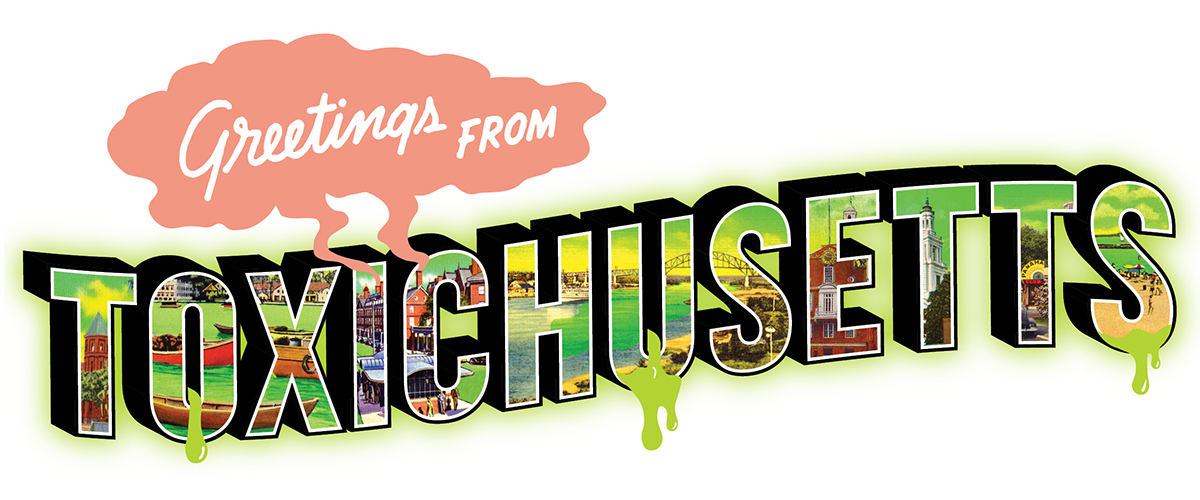All About Superfund Sites in Massachusetts

Illustrations by Post Typography
Massachusetts’ toxic legacy spans the country’s 300-year race toward industrialization. With an economy driven by manufacturing, we dumped noxious chemicals into our waterways and buried our industrial byproducts in our backyards. By the mid-20th century, we were paying for our carelessness with tainted drinking water and air laced with pernicious particles.
How bad was it? So bad that 35 years ago this month, President Jimmy Carter created the Environmental Protection Agency’s Superfund program to tackle the nation’s worst ecological catastrophes. The program remains among the most ambitious environmental undertakings in U.S. history. We now have 32 active Superfund sites in Massachusetts—the last just added in September, when a former industrial site in Franklin that dates back to the 1800s made the list.
First, a history lesson:
Now, here’s a map of all 32 active Superfund sites in Mass.:
(Zoom in—you’ll notice Attleboro, Bedford, New Bedford, and Woburn include two active Superfund sites.)
Let’s take a closer look at six local sites:
A Toxic Dump in the Berkshires
Year Designated: 1986
Status: Active
EPA Dollars Spent: $2.51 million
Throughout the 1950s, General Electric regularly dumped liquid waste at the Rose Disposal Pit in Lanesborough, nestled in the scenic foothills of the Berkshires. An EPA investigation discovered 15,000 cubic yards of toxic soil and two plumes of chemical-laced water that threatened nearby drinking wells. GE eventually agreed to cover the cleanup costs and reimburse the EPA.
The Ravages of War on the Cape
Year Designated: 1989
Status: Active
EPA Dollars Spent: $12.3 million
A joint military base in Falmouth posed such a severe threat to drinking water in May 1997 that the EPA put an end to military training at Camp Edwards, marking the first time in U.S. history that such activity was halted over environmental and public health concerns.
New Bedford’s Mutant Fish
Year Designated: 1983
Status: Active
EPA Dollars Spent: $622.3 million
They might not be Blinky, the three-eyed fish from The Simpsons, but the Atlantic killifish in New Bedford harbor have apparently undergone genetic changes that make them less susceptible to the deadly effects of the heavy metals and chemicals, left over from manufacturing, that pollute the water.
Woburn’s Spotlight Moment
Year Designated: 1983
Status: Active
EPA Dollars Spent: $28.8 million
Two contaminated wells in Woburn were the focus of a federal lawsuit against three companies, filed by eight local families who lost children to leukemia—a case made famous by the Jonathan Harr bestseller A Civil Action, and later adapted for the big screen in the John Travolta film.
From Toxic to Green in Billerica
Year Designated: 1984
Status: Active
EPA Dollars Spent: $28.4 million
Among the more-horrific-sounding dangers the EPA discovered at Iron Horse Park, in Billerica, was a giant asbestos landfill. The agency moved swiftly to cover it with gravel, stone, and soil to prevent nearby residents from “inhaling fugitive asbestos dust particles.” While the site remains significantly contaminated, it’s now home to a 6-megawatt solar-energy farm, which earned it one of the EPA’s first Re-Use Awards in 2014.
CLEAN!
Watertown Isn’t Radioactive Anymore
Year Designated: 1994
Status: Deleted
EPA Dollars Spent: $1.06 million
The grounds of a former U.S. Army lab in Watertown were once rife with radiation contamination. After a successful cleanup effort—the EPA removed its active-site designation in 2006, making it one of six deleted Superfund sites in the state—the property was converted into a corporate park. It’s now the headquarters of daycare behemoth Bright Horizons, among others.
What are the biggest problems?
Carbon Disulfide
At high levels, this industrial solvent and insecticide can damage the central nervous system.
Methyl Ethyl Ketone
It smells like butterscotch, but it can scorch your nostrils and eyes.
Polychlorinated Biphenyls
Also known as “PCBs,” these chemicals, ubiquitous in the state’s sites, have been linked to birth defects.
Thorium
This naturally occurring radioactive element may be everywhere, but heavy exposure can lead to lung and pancreatic cancer.
Vinyl Chloride
Used to make plastics and vinyl siding, this chemical is a confirmed carcinogen.
More burning questions, answered—by the numbers, of course:
How many Superfund sites could contaminate my groundwater?

How many Superfund sites risk exposing people to contaminants?

How many Superfund sites were added when these presidents were in office?

Source: United States Environmental Protection Agency


